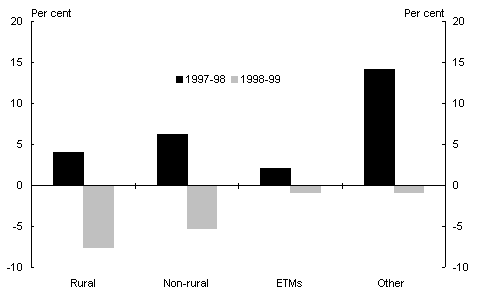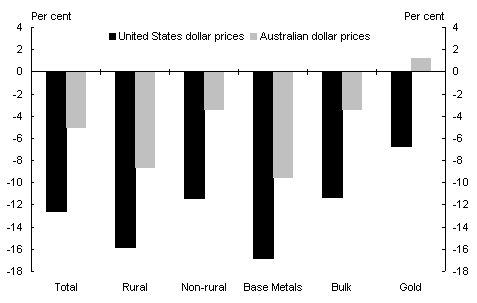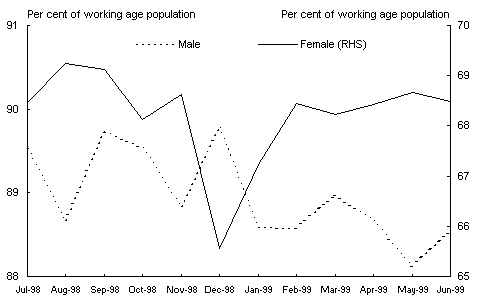Net exports detracted 0.7 percentage points from economic growth in 1998-99, slightly more than the MYEFO forecast, but less than the Budget forecast. Import volumes grew by 5 per cent in 1998-99, which was less than the Budget forecast of 9 per cent but higher than the revised MYEFO forecast of 3 per cent. The slower growth in import volumes reflected the increased competitiveness of domestic import-competing industries following the decline in the exchange rate in 1998-99. Export volumes grew by 1.7 per cent, slightly below the Budget forecast of 2 per cent and around the MYEFO forecast of 1 per cent. Behind this moderate growth in export volumes was the economic recession in Australias major trading partners in East Asia.
The current account deficit was $32.4 billion or 5.5 per cent of GDP in 1998-99, slightly above the May 1998 Budget forecast but broadly consistent with the MYEFO forecast. As expected, the higher CAD in 1998-99 reflected a deterioration in the balance of trade. This reflected the lower detraction from economic growth in net exports being offset by a greater than expected deterioration in the terms of trade.
The terms of trade fell by 5.1 per cent in 1998-99, primarily reflecting an average 4.8 per cent fall in the Australian dollar prices of Australian commodity exports. In contrast, the price of elaborately transformed manufactures (ETMs) experienced only a slight decrease (0.8 per cent) and import prices grew slightly. Chart 7 compares the percentage changes of the Australian dollar prices of export categories in 1997-98 and 1998-99.
Chart 7: Percentage changes of the Australian dollar prices of export categories

The decline in commodity prices in Australian dollar terms in 1998-99 represented a lagged response to the Asian financial and economic crisis. The major driving forces behind the declining prices of commodities included the outcome of annual trade negotiations of bulk commodities with major Asian trading partners, and the continued deterioration in the gold price through the year.
The economic recession in Japan and other Asian economies continued to depress the prices of commodities in the world market, particularly base metals and bulk commodities like iron ore, coking coal and steaming coal. The gold price remained depressed in 1998-99, falling further due to continued negative sentiment arising from uncertainty surrounding central bank sales and gold lending, and continued short selling by arbitrageurs.
The depreciation of the Australian dollar was not sufficient to prevent Australian dollar prices of Australian commodity producers from falling in 1998-99, given the extent of the decrease in the US dollar commodity prices. This was in contrast to the previous fiscal year when the prices of commodities declined in US dollar terms, but rose in Australian dollar terms.
Chart 8 compares the percentage changes of the prices of export categories in 1998-99 both in US dollar and Australian dollar terms.
Chart 8: Percentage changes of the prices of export categories in US dollars and Australian dollars, 1998-99

Prices, Wages and Employment
Inflation, as measured by movements in the Consumer Price Index (CPI) remained subdued in 1998-99, rising by 1.2 per cent in year-average terms (and 1.1 per cent in the year to the June quarter 1999). This outcome was lower than both the MYEFO and the 1998-99 Budget forecasts, and largely reflected robust productivity growth, moderate wages growth and continuing competitive pressures (both domestically and abroad). Heightened competitive pressures limited the pass-through to retail prices of higher import prices following from the depreciation of the exchange rate. Declining motor vehicle prices also served to moderate overall inflation, with the prices of motor vehicles falling for the fifth consecutive quarter to the June quarter 1999. This resulted in the lowest motor vehicle prices since 1992.
The introduction of the 30 per cent health insurance rebate on 1 January 1999 also contributed to the low inflation outcome as it reduced inflation by around of a percentage point in 1998-99.
Wages growth remained moderate in 1998-99, underpinned by low inflation. Average earnings on a national accounts basis (AENA) grew by 3.9 per cent, consistent with the 1998-99 MYEFO forecast. Abstracting from the increase in the superannuation guarantee charge on 1 July 1998, AENA grew by 3.5 per cent, slightly lower than the 1997-98 outcome of 3.7 per cent. Other measures of wages growth also confirmed a moderation AWOTE growth declined from 4.1 per cent in 1997-98 to 3.7 per cent in 1998-99, while the average annual wage increase for current enterprise agreements was 3.8 per cent in the June quarter 1999, compared to 4.1 per cent a year earlier. The spread of enterprise bargaining over recent years has ensured that sectoral wage pressures, such as in construction, IT and some skilled trades, were not transmitted more widely.
Moderate nominal wage increases, together with low inflation, resulted in relatively strong real wage growth in 1998-99. Nevertheless, robust productivity growth led to real unit labour costs being broadly unchanged over 1998-99.
Continued strong growth in domestic demand underpinned solid employment growth in 1998-99. Employment grew by 2.2 per cent in 1998-99, which was higher than both the May 1998 Budget forecast of 1 per cent and the MYEFO forecast of 2 per cent. The participation rate averaged 63.2 per cent over 1998-99; this was in line with the Budget forecast, but slightly below the MYEFO forecast of 63 per cent. It is possible that low mortgage interest rates and rising household wealth dampened labour force participation in 1998-99. As Chart 9 illustrates, the trend participation rate of prime working-age females was essentially flat over 1998-99, despite the strong employment growth experienced by this cohort. In addition, the participation rate of prime working-age males continued its long-term decline.
Chart 9: Participation rate of 25-59 year cohort, 1998-99

The unemployment rate continued to decline over the year, reaching a low of 7.2 per cent in June 1999. On average, over 1998-99, the unemployment rate was 7.6 per cent, which was lower than the Budget and the MYEFO forecasts of 8 per cent.
CONCLUSION
Ongoing microeconomic reform has improved the ability of the Australian economy to adapt quickly to changes in the Australian and international economy. While an increasingly diversified and productive economy has been fundamental in helping to mitigate the effects stemming from the Asian financial crisis, microeconomic reform has been complemented by sound and stable macroeconomic policies. Integrated macro and microeconomic policies have allowed the approp
riate exchange rate adjustments to take effect, which assisted to shield the Australian economy against the effects of heightened international instability and weakness.
The results of a more flexible economy and stable policy have (arguably) never been more apparent. In 1998-99, Australia achieved its most protracted period of economic growth since the early 1970s with sustained low inflation outcomes, rising employment, robust productivity growth and healthy corporate profitability. By international comparison, Australias economic performance in 1998-99 was very impressive, even surpassing the US economy on some measures.